July 2019 : Azores and heading north
LaterEarlier |
July has been a month of contrasting halves - unfortunately, neither involving much actual sailing! The first half of the month was spent on our holiday within a holiday – our ‘flying’ visit to the Azores – egged on by the fact that friends who had planned to join us at various stages of our aborted Azores odyssey had decided to go there anyway, or had already been there. We couldn’t be the only people in the whole enterprise not to actually to set foot in the Azores! So while our companions for the abandoned outward voyage busied themselves re-planning their trip, we too went into a flurry of online activity and within a day had come up with an Azores itinerary, booked return flights from Lisbon, four ferry trips and five sets of Airbnb accommodation and also found a suitable (cheap and secure) place to leave Aremiti for a couple of weeks. This turned out to be an excellent decision and we are so glad we went – albeit not quite as planned. For us, until that point, the focus had been on the sea passages to the Azores (and back) and the fact of these islands being an iconic yachting destination – rather than on the islands themselves. After all, we’d been planning to read the guidebooks during the outward voyage! We found them quite simply an extraordinary and fascinating island group – stuck right out there in the middle of the north Atlantic ocean – though we don’t really want to say too much for fear of starting a tourist boom! There are nine islands in all, spanning a distance east to west of about 400 miles. The easternmost island is 800 miles from Lisbon and the westernmost 1500 miles from New York – on the same latitude. They are formed at a point in the Atlantic Ocean where three tectonic plates are pulling apart causing the innumerable volcanoes apparent on all the islands, ongoing volcanic activity and earthquakes. The climate, influenced by the Gulf Stream is mild and equable, with a humidity which is loved by plants. There is quite an English look to the landscape – pastoral and green – but not quite. The islands each have their own contrasting character, but the bizarre juxtaposition of cows, hydrangeas and volcanoes is found on all of them. The basis of our plan was to replicate, as far as possible, what we had expected to do had we arrived there under our own steam. The original plan had been to cruise around seven islands over five weeks. This was condensed to five islands over two weeks – hence the ferry trips. Without in any way disrespecting Aremiti, we thoroughly enjoyed these ‘passages’, which were obviously faster, more comfortable and very relaxing. Three of the trips were made in the large ferry Aqua Jewel – Greek flagged (rather nostalgically for us) - currently chartered from the Greek company Seajets.
From here we made the 92 mile passage in just over six hours – rather than the 18 hours it would have taken in Aremiti - to Terceira. We were there just for a couple of nights enabling us to explore the grandly named capital Angra do Heroismo. This is the most beautiful town in the Azores – a gently colourful example of Rennaissance urban planning, with UNESCO World Heritage status. It was a delightful and bustling town – all the more so as we arrived in the middle of festivities celebrating Sao Joao. We were fascinated to hear American accents all around – visiting emigrant families returning home to their roots.
Our time in the Azores was unexpectedly sociable. We managed to rendezvous with both Trudy and Geoff and Jean for 2-3 days each which was some compensation for not being able to play host to them in Aremiti. Then by a huge co-incidence, we were able to meet Nick, a friend dating back to our circumnavigation, who sailed into Horta from Bermuda with friends while we were in the islands. We could not have had better or more appropriate friends to share a meal with in the Peter Sport Café – renowned hangout of yachties just above the marina. We flew back to Lisbon from Horta and found Aremiti patiently waiting for us in Nazare. Back to reality with a bit of a bump – as we faced both frustrations with the leaking waterlock and also the prospect of more slogging northwards up the Portuguese coast against the prevailing winds. It is a long and unforgiving coastline with few ports – and several of those not very enticing with warnings of yachtsmen having lost their lives attempting to enter in the wrong conditions. However, we were able to make our rendezvous with Chris from our sailing association, in Porto, on time - on the same date as we were supposed to have met him in Horta had things gone to plan. The idea was to get ourselves 71 miles further north to Baiona in Spain – at the southern end of the Rias. The Rias of Galicia are a series of deep and rocky indentations in the coastline all around the north-western corner of Spain which provide a beautiful cruising area for yachts. Sailing there would be a new experience for Chris and we were looking forward to showing him some of our favourite places, before setting off across the notorious Bay of Biscay. However, we were held up in Porto – interminably it seemed, but actually only three days – by a pulse of extra strength northerly winds. Not really too terrible a place to be stuck in and we made good use of our time in a marina just into the mouth of the River Douro. Lovely friendly marina – every morning two bread rolls per person would be dropped into our cockpit!
Finally we were able to move north, setting off early into a thick fog for the 37 mile passage to Viana do Castelo. It was slightly unfortunate – or maybe exciting – that our timing involved passing the large harbour of Leixoes just as the fishing fleet was returning home. We knew this only from our AIS display which showed the boats streaming back there, all around us. We never actually saw any of them – though some were only a few hundred metres away. They were evidently also keeping watch – a rare thing. Arriving in Viana at around 2pm we were immediately presented with a meal of sardines, bread and tomatoes by a neighbouring boat – most welcome as we had not yet eaten! Viana, an elegant little town was in the throes of a week long folk dance festival. We enjoyed a late night show of dancers from several countries, each having their own take on what constitutes folk dancing – from the slightly solemn and very traditional Rumanians to a bizarre extravaganza put on by the troupe from Mexico owing more to Broadway than folk tradition.
The Rias have changed considerably even in the past eight years since our last visit, and even more so since our first visit 20 years ago. This is no longer quite the quiet, mystical little bit of Celtic Spain it was – although some of the weather was quite Celtic.
Our departure has been held up for several days – during which time we have enjoyed a couple of walks with mesmerising views of waves pounding on to rocks and we have now actually taken part in a fiesta! Having previously observed the flotillas of fishing boats parading statues out to sea, this time we managed to get ourselves on one of the boats – quite easy, we just asked – to spend a couple of hours roaring around the Ria, celebrated at various points by salvos of bombas. Great fun! 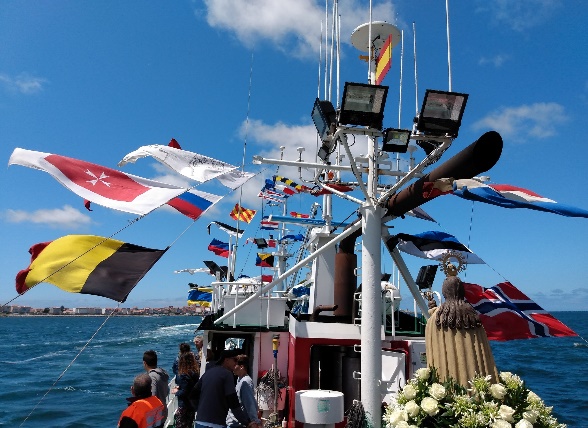 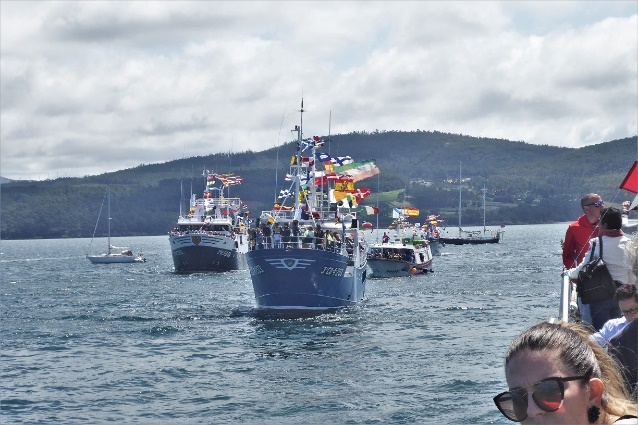
We have now moved another 50 miles north-eastwards to the large and gracious city of A Coruna – where – surprise surprise - there is another fiesta – medieval this time! The Shipping Forecast for our area – Fitzroy - demonstrates why we’re still here:
GALE WARNING Issued: 03:40 (UTC) on Mon 29 Jul 2019 Northwesterly violent storm force 11 decreasing severe gale force 9 imminent WIND In south, westerly 5 to 7, occasionally gale 8 in north, veering northwesterly 4 to 6. In north, cyclonic gale 8 to storm 10 becoming northwesterly 6 to gale 8, decreasing 4 or 5 later in west. SEA STATE In south, rough or very rough, occasionally high at first in north. In north, very rough or high becoming rough or very rough. WEATHER In south, showers. In north, thundery showers. VISIBILITY In south, moderate or good. In north, poor becoming good. |
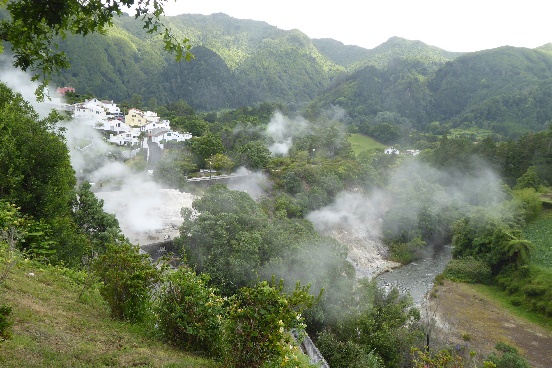 We flew into Ponta Delgada on the island of San Miguel – the largest and most varied of the islands.
Highlights were the town itself with its black and white architecture – much use of volcanic rock, the caldeira of Sete Cidades with its two lakes one blue and one green, and the lively volcanic activity – bubbling mud, steaming water of Furnas.
We flew into Ponta Delgada on the island of San Miguel – the largest and most varied of the islands.
Highlights were the town itself with its black and white architecture – much use of volcanic rock, the caldeira of Sete Cidades with its two lakes one blue and one green, and the lively volcanic activity – bubbling mud, steaming water of Furnas.
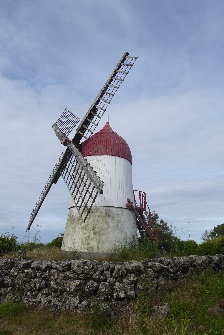 From Terceira to Graciosa – 45 miles. This is one of the smallest of the islands – relaxed and rural. With a picturesque scenery of pastures, walled enclosures and red topped windmills, the activities of the island centre on cows and wine. We found it interesting that none of the islands seem to engage in serious fishing activity, and the cuisine is very meat orientated. Possibly the cost of fully protecting these harbours in the middle of the Atlantic would be prohibitive. A highlight of our few days here was a visit to the caldeira, which started to build 50,000 years ago resulting in lava tunnels and a cavern with a lake 22 metres below sea level.
From Terceira to Graciosa – 45 miles. This is one of the smallest of the islands – relaxed and rural. With a picturesque scenery of pastures, walled enclosures and red topped windmills, the activities of the island centre on cows and wine. We found it interesting that none of the islands seem to engage in serious fishing activity, and the cuisine is very meat orientated. Possibly the cost of fully protecting these harbours in the middle of the Atlantic would be prohibitive. A highlight of our few days here was a visit to the caldeira, which started to build 50,000 years ago resulting in lava tunnels and a cavern with a lake 22 metres below sea level.
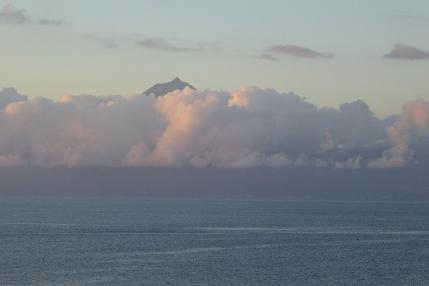 Next to Pico - the youngest of the islands with a landscape strewn with jagged and unforgiving black lava. We had our first sight of the iconic volcano of Pico from Graciosa, 40 miles away – peeking up above the clouds. We found the volcano utterly compelling and were constantly checking whether or not it was visible or shrouded in cloud at any particular time. The peak is 2351 metres high - a serious climb.
Next to Pico - the youngest of the islands with a landscape strewn with jagged and unforgiving black lava. We had our first sight of the iconic volcano of Pico from Graciosa, 40 miles away – peeking up above the clouds. We found the volcano utterly compelling and were constantly checking whether or not it was visible or shrouded in cloud at any particular time. The peak is 2351 metres high - a serious climb. 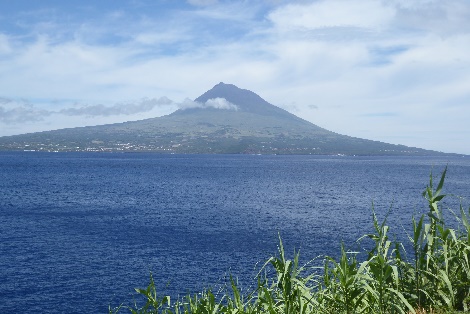 Given that the view from the peak is frequently smothered in fog – and that we’re so old – we decided just to keep an eye on it, rather than climb it. Wine production is a major activity on Pico and we marvelled at the acres of vineyards where the vines are grown between sharp looking walls of lava.
Given that the view from the peak is frequently smothered in fog – and that we’re so old – we decided just to keep an eye on it, rather than climb it. Wine production is a major activity on Pico and we marvelled at the acres of vineyards where the vines are grown between sharp looking walls of lava. 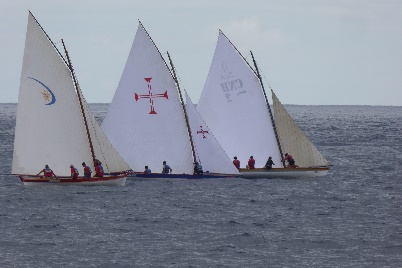 We were also lucky to encounter a regatta of traditional sailing whaling boats – harking back to another major industry on the island until relatively recently.
We were also lucky to encounter a regatta of traditional sailing whaling boats – harking back to another major industry on the island until relatively recently.
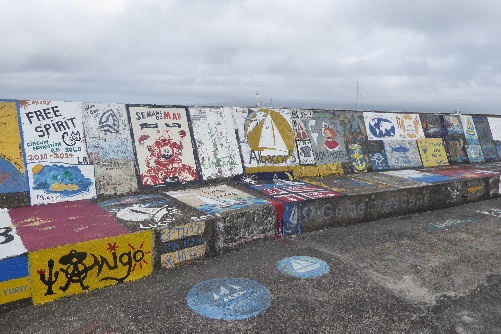 Finally to Faial – a quick 30 minute ferry trip from Pico. The port of Horta would have been our ultimate destination in the Azores, being a mecca for trans-Atlantic yachting. It has the largest collection of maritime paintings around the marina in the world – all making us feel rather wistful …
Another highlight was a trip to the other end of the island to visit Calderinhos – the site where a volcanic eruption in 1957 partly covered a lighthouse and created 2.7 km² of new land – an extraordinary and unearthly landscape.
Finally to Faial – a quick 30 minute ferry trip from Pico. The port of Horta would have been our ultimate destination in the Azores, being a mecca for trans-Atlantic yachting. It has the largest collection of maritime paintings around the marina in the world – all making us feel rather wistful …
Another highlight was a trip to the other end of the island to visit Calderinhos – the site where a volcanic eruption in 1957 partly covered a lighthouse and created 2.7 km² of new land – an extraordinary and unearthly landscape.
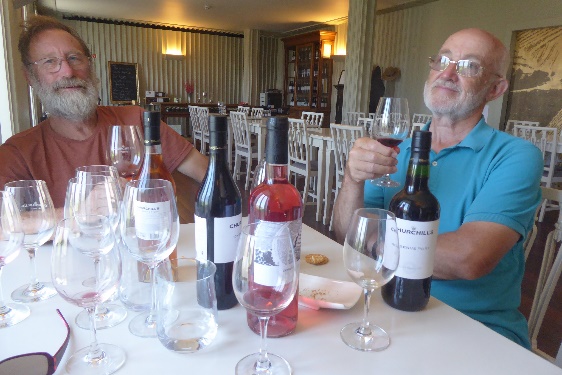 We had all visited Porto previously, but were more than happy to spend a morning strolling around the Porto side of the Douro, before moving on across the river to Gaia – location of the great port houses – where we forced ourselves to spend the afternoon tasting several different types of port! Perhaps the highlight of our stay here was in exploring the village of Afurada right beside the marina. The village which appeared to have been built in around the 1950s continues a very traditional lifestyle. While the men are out fishing, the women seem to focus their social life on the laundry. There is a communal wash-house (built only in 2003) with a large area of washing lines on wooden poles outside it. The women bring and take back their laundry in large bowls carried on their heads – many wearing similar style aprons trimmed with lace. We were frustrated not to be able to discover when, why and how the present village buildings had been built and what they had replaced.
We had all visited Porto previously, but were more than happy to spend a morning strolling around the Porto side of the Douro, before moving on across the river to Gaia – location of the great port houses – where we forced ourselves to spend the afternoon tasting several different types of port! Perhaps the highlight of our stay here was in exploring the village of Afurada right beside the marina. The village which appeared to have been built in around the 1950s continues a very traditional lifestyle. While the men are out fishing, the women seem to focus their social life on the laundry. There is a communal wash-house (built only in 2003) with a large area of washing lines on wooden poles outside it. The women bring and take back their laundry in large bowls carried on their heads – many wearing similar style aprons trimmed with lace. We were frustrated not to be able to discover when, why and how the present village buildings had been built and what they had replaced.
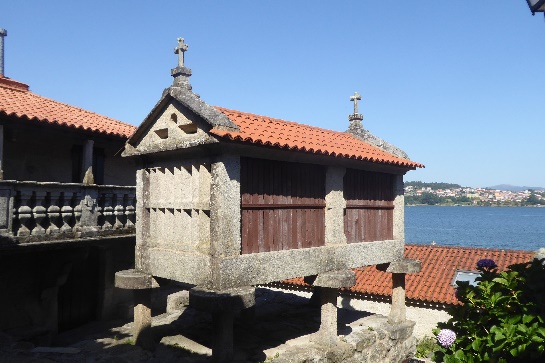
 Next, into Spain, to Baiona – a town of quaint little grey stone streets – where we were reminded of the Celtic heritage of Galicia by a little religious procession which passed as we were enjoying a meal out, headed by a band of bagpipers.
Into the Rias now, we were looking forward to showing Chris one of our favourite places – Combarro – but were horrified at the touristification of the hugely picturesque little village since our last visit. However, as we wandered grumpily around admiring horreos through hordes of other visitors, all was redeemed when we reached a tiny chapel just in time to catch a parade of the virgin statue down to the port, headed by a band of bagpipers. Here the statue was loaded on to a large fishing boat and, accompanied by a large flotilla of flag bedecked boats, processed out into the ria.
Next, into Spain, to Baiona – a town of quaint little grey stone streets – where we were reminded of the Celtic heritage of Galicia by a little religious procession which passed as we were enjoying a meal out, headed by a band of bagpipers.
Into the Rias now, we were looking forward to showing Chris one of our favourite places – Combarro – but were horrified at the touristification of the hugely picturesque little village since our last visit. However, as we wandered grumpily around admiring horreos through hordes of other visitors, all was redeemed when we reached a tiny chapel just in time to catch a parade of the virgin statue down to the port, headed by a band of bagpipers. Here the statue was loaded on to a large fishing boat and, accompanied by a large flotilla of flag bedecked boats, processed out into the ria.
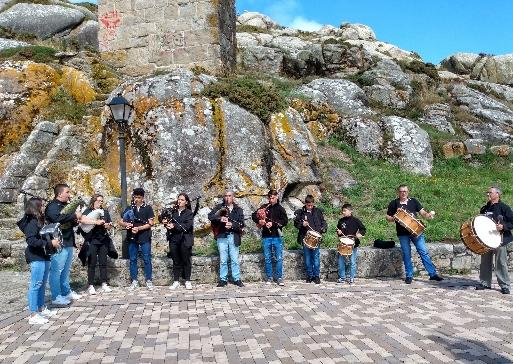 This was quite a whistle-stop tour and we next moved on 39 miles to Muros – a delightful grey stone town with Galician style windowed balconies – and an impressive fleet of large fish farm boats.
The weather turned very Celtic for most of the day of our passage onwards to the harbour of Fisterra – our very most favourite place. Here we were greeted as we approached by a fleet of dolphins playing languidly around the boat, as the sun finally conquered the fog – magical! We always find the harbour of Fisterra a very special and uplifting sight. On going ashore we encountered a fishing boat unloading an extraordinary number of extraordinarily huge conger eels. We know not where they were bound – or why. We then found the quirky bar we have frequented on previous visits – with a fantastic view over the bright and colourful harbour and a funky choice of music. We could live there!
This was quite a whistle-stop tour and we next moved on 39 miles to Muros – a delightful grey stone town with Galician style windowed balconies – and an impressive fleet of large fish farm boats.
The weather turned very Celtic for most of the day of our passage onwards to the harbour of Fisterra – our very most favourite place. Here we were greeted as we approached by a fleet of dolphins playing languidly around the boat, as the sun finally conquered the fog – magical! We always find the harbour of Fisterra a very special and uplifting sight. On going ashore we encountered a fishing boat unloading an extraordinary number of extraordinarily huge conger eels. We know not where they were bound – or why. We then found the quirky bar we have frequented on previous visits – with a fantastic view over the bright and colourful harbour and a funky choice of music. We could live there!
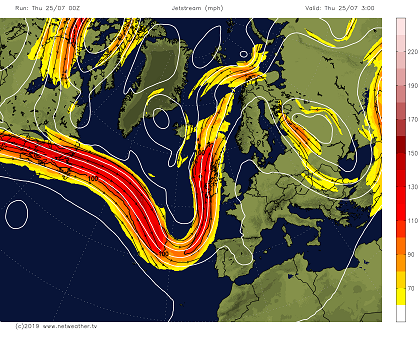 The plan was to make our departure across Biscay from the Ria of Camarinas – our passage there taking us past the notorious Costa del Morte. Here we were confronted by the difficulties of making decisions about such passages on the basis of ever changing forecasts – not easy to achieve the mental state of being simultaneously ready to pounce on the slightest chance of a weather window, but also in relaxed cruising mode ready to explore the area and attend any available fiestas. The weather on this coast this summer has continued unstable, as the jet stream has come far south into the Atlantic – giving us chilly winds and dampness, while the UK and much of the rest of Europe has sweltered in extreme heatwaves.
The plan was to make our departure across Biscay from the Ria of Camarinas – our passage there taking us past the notorious Costa del Morte. Here we were confronted by the difficulties of making decisions about such passages on the basis of ever changing forecasts – not easy to achieve the mental state of being simultaneously ready to pounce on the slightest chance of a weather window, but also in relaxed cruising mode ready to explore the area and attend any available fiestas. The weather on this coast this summer has continued unstable, as the jet stream has come far south into the Atlantic – giving us chilly winds and dampness, while the UK and much of the rest of Europe has sweltered in extreme heatwaves.